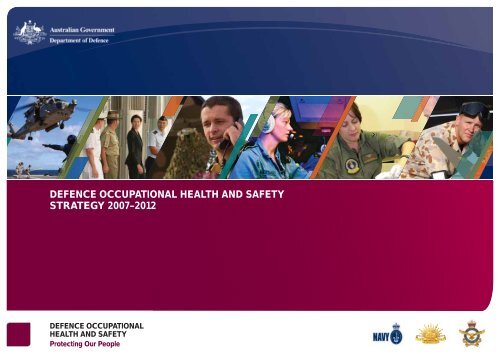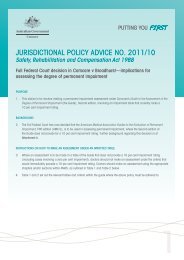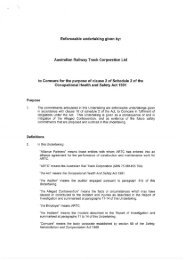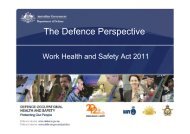Defence Occupational Health and Safety Strategy 2007-1 - Comcare
Defence Occupational Health and Safety Strategy 2007-1 - Comcare
Defence Occupational Health and Safety Strategy 2007-1 - Comcare
- No tags were found...
Create successful ePaper yourself
Turn your PDF publications into a flip-book with our unique Google optimized e-Paper software.
CONTENTS<strong>Defence</strong> OHS Vision . . . . . . . . . . . . . . . . 2Foundation Objectives . . . . . . . . . . . . 8Operational Objectives . . . . . . . . . . . 10Enabling Objectives . . . . . . . . . . . . . . 13Message from the DOHSC Chairman . . 3> OHS Strategic Objective 1 . . . . . . . . 8> OHS Strategic Objective 3 . . . . . . . 10> OHS Strategic Objective 6 . . . . . . . 13Governance . . . . . . . . . . . . . . . . . . . . . . 4> OHS Strategic Objective 2 . . . . . . . . 9> OHS Strategic Objective 4 . . . . . . . 11> OHS Strategic Objective 7 . . . . . . . 14The Changing <strong>Defence</strong> Environment . . . 5> OHS Strategic Objective 5 . . . . . . . 12> OHS Strategic Objective 8 . . . . . . . 15Present <strong>and</strong> Emerging Issues . . . . . . . . 6<strong>Defence</strong> OHS Strategic Objectives . . . . 7Copies of the <strong>Defence</strong> OHS <strong>Strategy</strong> <strong>and</strong>supporting documentation are availablevia the <strong>Defence</strong> OHS Portalhttp://ohsc.defence.gov.au/OHSMS/Comment <strong>and</strong> feedback is welcome viaohsc@defence.gov.au<strong>Defence</strong> Intranet ohsc.defence.gov.auInternet www.defence.gov.au/dpe/ohsc
DEFENCEOHS VISION‘Through leadership <strong>and</strong> individual commitment, <strong>Defence</strong> willcontinue to place a high priority on the occupational health <strong>and</strong>safety (OHS) of its people, thus protecting them <strong>and</strong> enhancingcapability <strong>and</strong> readiness. We aim to eliminate all preventablework-related injuries <strong>and</strong> illness through the systematic managementof our risks. We will strive to make measurable improvement inour occupational health <strong>and</strong> safety performance through theimplementation of the <strong>Defence</strong> OHS <strong>Strategy</strong>.’ACM Angus Houston, AO, AFCChief of the <strong>Defence</strong> ForceNick Warner, PSMSecretary
MESSAGE FROM THE DOHSC CHAIRMANThe <strong>Defence</strong> OHS <strong>Strategy</strong> defi nes the strategicobjectives that are required to achieve our desiredOHS culture <strong>and</strong> deliver a high st<strong>and</strong>ard of OHSperformance. It articulates our OHS policy <strong>and</strong>expected outcomes.The <strong>Defence</strong> OHS Strategic Plan 2004-2006 identifi ed three phases to achieve OHSimprovement in <strong>Defence</strong>: Reposition, Reshape<strong>and</strong> Realise. The primary objective of this<strong>Defence</strong> OHS <strong>Strategy</strong> will be to reshape <strong>Defence</strong>OHS management <strong>and</strong> realise performanceimprovements. The foundation of this work isdeveloping <strong>and</strong> implementing the elements of the<strong>Defence</strong> OHS Management System (OHSMS), acritical element of which is the OHS ManagementInformation System (OHSMIS).The <strong>Defence</strong> OHSMS provides a planned,documented <strong>and</strong> quantifi able approach for thecomprehensive <strong>and</strong> systematic managementof OHS. Our OHSMS encompasses the areasof leadership, incident prevention, incidentmanagement, <strong>and</strong> supporting managementarrangements. It provides the architecture toembed a repeatable way of managing OHS thatincludes the integration of deliberate practices,processes <strong>and</strong> linkages, while remainingsuffi ciently fl exible <strong>and</strong> responsive to meetchanging dem<strong>and</strong>s.We seek to move beyond a simple focus onlegislative compliance <strong>and</strong> evolve into a valuesbased,learning organisation. Thus, proactivelymanaging all workplace hazards to protect ourpeople across the spectrum of activities we areengaged in including deployments, operations<strong>and</strong> working at <strong>Defence</strong> facilities. Our <strong>Defence</strong>values guide the behaviour of our people, atevery level of the organisation, <strong>and</strong> will underpinour desired OHS culture. We will have achievedour desired OHS culture when:>>>>>>OHS is recognised as a force multiplier byits inherent link to force preservation <strong>and</strong>sustainability of operations, <strong>and</strong> is embeddedin all capability development, acquisition,contracting, design, operational planning,operations <strong>and</strong> business activities.OHS roles <strong>and</strong> responsibilities at all levelsare clear <strong>and</strong> understood, supported bydemonstrated leadership commitment <strong>and</strong>integrated into people management systems.Accurate OHS information is captured <strong>and</strong>disseminated in an effective <strong>and</strong> timely mannerthrough integrated systems <strong>and</strong> is used indecision making.All personnel accept responsibility for theiroccupational health <strong>and</strong> safety, <strong>and</strong> that ofothers in the workplace, <strong>and</strong> regard it as anintegral part of the daily working routine.Innovative, healthy <strong>and</strong> safe work practicesare supported through appropriate reward<strong>and</strong> recognition.Emphasis is given to identifying root causesof incidents, taking preventive action, <strong>and</strong>ensuring lessons are learned.>All <strong>Defence</strong> personnel, Australian <strong>Defence</strong>Force Cadets <strong>and</strong> Contractors apply valuebased decisions that contribute to a <strong>Defence</strong>wide safe <strong>and</strong> healthy work environment.Implementation of the <strong>Defence</strong> OHS <strong>Strategy</strong>will take place at two levels: the corporate level<strong>and</strong> the individual Service <strong>and</strong> Group level. At thecorporate level, the objective will continue to be theachievement of Strategic Objectives that requirea coordinated approach across the Services <strong>and</strong>Groups. At Service <strong>and</strong> Group level, the objectivewill be on implementing arrangements to meet theindividual organisations’ needs while supportingcorporate OHS improvement initiatives.As Chair of the DOHSC, I will supportimplementation of this <strong>Strategy</strong> by:>>>>coordinating the development <strong>and</strong> maintenanceof the <strong>Defence</strong> OHSMS to achieve effectiveimplementation within individual Services <strong>and</strong>Groups;ensuring the OHSMS supports joint <strong>and</strong>interagency operations;aiding the Services <strong>and</strong> Groups to translatecorporate improvement initiatives into actionsthat effectively meet their individual OHSmanagement requirements;assisting the Services to develop approachesfor managing OHS in joint operationalenvironments;>>>>working collaboratively with the Services<strong>and</strong> Groups to identify <strong>and</strong> address commonOHS management issues;guiding development of policy <strong>and</strong> practicesfor OHS hazard <strong>and</strong> risk management that areunderst<strong>and</strong>able <strong>and</strong> effective;ensuring, as chair of the DOHSC, thatproposals for improved OHS managementare appropriately considered <strong>and</strong> funded; <strong>and</strong>coordinating corporate level OHS initiatives,concentrating on the highest priorityimprovements that can be achievedwithin available resources.Allocation of resources to meet the priorities of this<strong>Strategy</strong> will be addressed through Service <strong>and</strong>Group budget estimates processes, the <strong>Defence</strong>Management <strong>and</strong> Finance Plan, the <strong>Defence</strong>Workforce Plan <strong>and</strong>, in respect of corporateinitiatives, funding from DOHSC. In developing ourOHS capability we also need to recruit <strong>and</strong> developOHS professionals, specialists <strong>and</strong> representativesto play key roles in OHS management.Major General Mick Slater, DSC, AM, CSCChairman,<strong>Defence</strong> <strong>Occupational</strong> <strong>Health</strong><strong>and</strong> <strong>Safety</strong> Committee4
GOVERNANCEThe <strong>Defence</strong> OHS <strong>Strategy</strong> is consistent with<strong>Defence</strong>’s existing governance arrangements.These arrangements are refl ected in the MinisterialDirective to the Secretary <strong>and</strong> CDF <strong>and</strong> cascadedown to the Service Chiefs <strong>and</strong> Group Headsthrough Charter Letters <strong>and</strong> OrganisationalPerformance Agreements. Customer ServiceAgreements provide the mechanism fordocumenting inter-Service/Group arrangements,<strong>and</strong> provide the accountability framework fordirecting <strong>and</strong> controlling performance in <strong>Defence</strong>.OHS is integral to delivering capability <strong>and</strong> isimplicit within these governance arrangements.The <strong>Defence</strong> Committee’s (DC) role is to makedecisions aimed at achieving the outcomesspecifi ed in the Ministerial Directive to the CDF <strong>and</strong>Secretary. The DC focuses on the longer term,giving direction <strong>and</strong> assessing performance indelivering results.The <strong>Defence</strong> <strong>Occupational</strong> <strong>Health</strong> <strong>and</strong> <strong>Safety</strong>Committee (DOHSC) is a DC sub-committeeresponsible for oversighting the <strong>Defence</strong> OHS<strong>Strategy</strong> <strong>and</strong> supporting activities. The Chair ofthe DOHSC is responsible <strong>and</strong> accountable tothe Secretary <strong>and</strong> CDF, the designated employersunder the <strong>Occupational</strong> <strong>Health</strong> <strong>and</strong> <strong>Safety</strong>Act 1991. The DOHSC reports to the DC onsignifi cant OHS issues <strong>and</strong> annual progress withimplementing the <strong>Defence</strong> OHS <strong>Strategy</strong>.The Chair of the DOHSC is also the principal OHSpolicy adviser to the DC <strong>and</strong> is responsible forproviding a corporate OHS policy <strong>and</strong> governanceframework.Service Chiefs <strong>and</strong> Group Heads are responsiblefor the OHS performance of their respectiveorganisations <strong>and</strong> reporting to the DOHSC.OHS performance to meet statutory reportingrequirements, including the <strong>Defence</strong> AnnualReport, is coordinated through the <strong>Occupational</strong><strong>Health</strong>, <strong>Safety</strong> <strong>and</strong> Compensation Branch.5
THE CHANGINGDEFENCE ENVIRONMENT:IMPLICATIONS FOR THEMANAGEMENT OF OHSThe primary role of <strong>Defence</strong> is to provide Governmentwith military options for the conduct of operationsto defend Australia <strong>and</strong> its national interests. Thisresponsibility, together with the dem<strong>and</strong>ing <strong>and</strong>complex nature of the <strong>Defence</strong> environment, givesrise to challenges in meeting our obligation to make<strong>Defence</strong> a safe workplace for our people.First, there is the challenge created by the size <strong>and</strong>geographic spread of the <strong>Defence</strong> workforce. The<strong>Defence</strong> workforce is made up of over 100,000personnel, comprised of:>>permanent <strong>and</strong> reserve force members ofthe Navy, Army <strong>and</strong> Air Force, together withthe cadets from each of the Services;civilianemployees engaged in an ongoing or nonongoing(temporary) capacity under the PublicService Act 1999; <strong>and</strong>private sector contractors working throughout,<strong>and</strong> frequently embedded within, the <strong>Defence</strong>workforce.In addition to working throughout Australia, frommajor metropolitan <strong>and</strong> rural centres to remotelocalities, our people are deployed on operationsoverseas, <strong>and</strong> work in overseas missions,embassies <strong>and</strong> posts throughout the world.There is vast diversity in the nature of workperformed by <strong>Defence</strong> personnel. Militarypersonnel are engaged in ‘warlike’, ‘nonwarlike’<strong>and</strong> ‘peacetime’ operations, includingpeacekeeping <strong>and</strong> humanitarian relief operations,as well as training for such operations. Whileinitial operational training is conducted underthe auspices of the individual Services, we areincreasingly mounting joint ADF operations <strong>and</strong>frequently in coalition with overseas military forces.Support activities performed across <strong>Defence</strong> byboth military <strong>and</strong> civilian personnel encompassan extensive range of functions <strong>and</strong> employmentcategories, including scientifi c, engineering, technical,logistical <strong>and</strong> administrative support together withpolicy development <strong>and</strong> planning. It is fair to saythat <strong>Defence</strong> has a greater range of employmentcategories than any other Australian employer.Overriding all of this, are the risks - in some cases,extreme risks - associated with the nature ofmilitary service. The principal distinguishing featureof military service is, of course, the obligation toserve in combat operations. No other employmentgroup has the same liability. Increased operationaltempo as a result of participation in peacekeeping<strong>and</strong> overseas coalition operations has highlightedthis obligation <strong>and</strong> the inherent risks involved indeployed operations.Despite our desire <strong>and</strong> best efforts to do so, therisks inherent in military service can never becompletely removed. Other than the obvious risksassociated with operational service, ADF trainingactivities are aimed at exercising military skills insimulated combat situations, which by necessityleads to elevated risk environments, albeit wherethe risks are controlled to the maximum extentpracticable. Moreover, many military activitiesrequire personnel to work long <strong>and</strong> irregular hoursof duty in adverse or arduous conditions, thuscompounding the risks.Within this large <strong>and</strong> diverse employmentenvironment the ability to sustain our mostimportant asset - Our People - is paramount.Accordingly OHS becomes a capability enhancerof crucial importance to all personnel. In addition,<strong>and</strong> notwithst<strong>and</strong>ing the unique nature of militaryservice, <strong>Defence</strong> is not immune from complyingwith the OHS Act <strong>and</strong> related legislation. While thedem<strong>and</strong>s made of <strong>Defence</strong> <strong>and</strong> its personnel mayat times be higher than for the rest of the Australianworkforce, the st<strong>and</strong>ards relating to OHS remainthe same as for the wider community.6
PRESENT ANDEMERGING ISSUESAgainst this background, it is considered that inthe short to medium term the following issues willhave implications for the management of OHSwithin <strong>Defence</strong>:>>The expectations of those entering, oralready working in <strong>Defence</strong>, together withthe expectations of Government <strong>and</strong> widercommunity, are likely to increase insofar as theeffective management of OHS is concerned.This can be expected to have a direct bearing on<strong>Defence</strong>’s reputation <strong>and</strong>, therefore, our ability toattract, recruit <strong>and</strong> retain quality people.It is likely that further legislation relating eitherdirectly or indirectly to OHS will be enactedover time, <strong>and</strong> that <strong>Defence</strong> will be subject toincreasing regulation <strong>and</strong> external scrutiny.>>Operational tempo is unlikely to diminish,<strong>and</strong> may increase, in response to changesin the international security environment orthe Government’s strategic <strong>Defence</strong> policy.The instability being experienced within ourown region may increase, potentially leadingto further regional deployments. Increasedoperational activity invariably leads toheightened OHS risks for our people.Pressures within the Australian labour market,combined with substantial demographic shifts,will continue to constrain <strong>Defence</strong>’s capacity toattract high quality recruits to the ADF <strong>and</strong> thecivilian workforce.>>The large-scale acquisition of new platforms<strong>and</strong> equipment, coupled with the potentialfor signifi cant new occupational hazardsassociated with emerging technologies, can beexpected to generate new OHS challenges.High operational tempo along witha constant drive to achieve greaterproductivity <strong>and</strong> improved performanceacross the <strong>Defence</strong> workforce may leadto increased psychological injuries.The preceding factors suggest increasingdem<strong>and</strong>s will be made in relation to themanagement of OHS, a prediction consistentwith the growing importance of OHS over the lasttwo decades. These factors indicate <strong>Defence</strong> willface continuing pressure to reduce the frequency<strong>and</strong> severity of work related injuries <strong>and</strong> illnessesamong <strong>Defence</strong> personnel in order to maintain ourexisting levels of capability while containing costs.7
DEFENCE OHSSTRATEGICOBJECTIVESThe fi rst, or ‘Reposition’ edition of the <strong>Defence</strong> OHS StrategicPlan 2004-2006 established 8 priority areas for action, broadlygrouped into outcome priorities <strong>and</strong> enabling priorities. Wehave made progress during the ‘Reposition’ phase of the‘Strategic Plan’, agreeing the <strong>Defence</strong> OHSMS as theenterprise-level architecture for managing OHS <strong>and</strong>defi ning roles <strong>and</strong> responsibilities. As we transitionto the ‘Reshaping’ phase, a review of the prioritiescontained in the <strong>Defence</strong> OHS Strategic Plan2004-2006 reveals that the initial thinking wassound. The original 8 Priorities have beenrecast as Strategic Objectives <strong>and</strong> prioritisedto better focus our efforts.Foundation Objectives1. Further develop <strong>and</strong> implement the elementsof the <strong>Defence</strong>-wide OHSMS.2. Develop <strong>and</strong> implement a <strong>Defence</strong> OHSManagement Information System to improvethe quality of OHS information available todecision-makers at all levels.Outcome Objectives3. Reduce the frequency <strong>and</strong> severityof risks to people’s health <strong>and</strong> safety.4. Improve prevention of occupationalinjury, illness <strong>and</strong> disease.5. Reduce the impact of occupationalinjury, illness <strong>and</strong> disease.Enabling Objectives6. Train, support <strong>and</strong> motivate personnel toidentify <strong>and</strong> manage hazards effectively.7. Improve <strong>and</strong> embed a systematic capabilityto identify, eliminate or manage hazards inthe design <strong>and</strong> planning stages of <strong>Defence</strong>activities.8. Enable <strong>Defence</strong> personnel to manage the OHSperformance of third parties, consistent with<strong>Defence</strong> policies <strong>and</strong> practices.The <strong>Defence</strong> Strategic Objectives are explained ingreater detail in the following pages.8
FOUNDATIONOBJECTIVESSTRATEGIC OBJECTIVE 1:Strategic Objectives 1 <strong>and</strong> 2 are called Foundation Objectives as it has been decided that:> The OHSMS (Strategic Objective 1) is the underlying basis for all > To enable comm<strong>and</strong>ers <strong>and</strong> managers to be effective in their planning,implementation activity at the corporate level. While establishing minimum leadership <strong>and</strong> decision-making they must have access to timely <strong>and</strong>st<strong>and</strong>ards <strong>and</strong> common outcomes, it will allow practices to be tailoredaccurate information. Provision of an enterprise-based managementto Service <strong>and</strong> Groups specifi c requirements. The development of ainformation system (Strategic Objective 2) to support decision-makers issystematic OHS capability, which is integrated with related <strong>Defence</strong>therefore the second foundation objective.management frameworks <strong>and</strong> based on a risk management approach,provides a foundation on which to improve our OHS performance.Further develop <strong>and</strong> implement theelements of the <strong>Defence</strong>-wide OHSMSThe ability of <strong>Defence</strong> to sustain improvementsin OHS performance is dependent on developingan effective OHSMS, <strong>and</strong> supportive culture.External research reveals that best practiceorganisations adopt a consistent, systematicapproach to managing OHS, focusing onoccupational health promotion <strong>and</strong> hazardelimination as the underlying purpose of OHSsystems. Further, it indicates that a positiveOHS culture (the acceptance of OHS as a coreorganisational value in the minds of leaders, staff<strong>and</strong> contractors) is required in support of a robustOHS management system if enduring performanceimprovement is to be achieved.The <strong>Defence</strong> OHSMS purpose is to create asustainable capability through a comprehensive<strong>and</strong> integrated architecture where the Services <strong>and</strong>Groups can manage the risks arising from <strong>Defence</strong>activities. It must also enable risks to be managedeffectively across organisational boundaries.The Key Strategies for Objective 1 are:>>The <strong>Defence</strong> OHSMS will have principlesbasedpolicies <strong>and</strong> implementation plans thatare adaptable to the needs of the Services<strong>and</strong> Groups -so that their individual OHSmanagement system can be confi gured tosupport integration with the <strong>Defence</strong> OHSMS.Gaps between current practice <strong>and</strong>OHSMS requirements will be identifi ed <strong>and</strong>implementation plans developed for eachService <strong>and</strong> Group, <strong>and</strong> <strong>Defence</strong> as a whole.> The mechanisms to drive cultural change,including the role of education <strong>and</strong> training,communications, recognition <strong>and</strong> reward,will be determined <strong>and</strong> appropriate actionsincorporated into implementation plans.9
STRATEGIC OBJECTIVE 2:Develop <strong>and</strong> implement a <strong>Defence</strong> OHSManagement Information System to improvethe quality of OHS information available todecision-makers at all levelsComm<strong>and</strong>ers <strong>and</strong> Managers require accurate <strong>and</strong>timely OHS information to manage <strong>and</strong> report OHSperformance effectively, ensure compliance withstatutory requirements <strong>and</strong> apply their resourcesfor maximum effect. The ability to initiate timelyinterventions depends on receiving information onrelevant lead indicators of performance.<strong>Defence</strong> must improve its capacity to detectrecurring incidents <strong>and</strong> learn from experience.Methods that enable the sharing of information,lessons learned <strong>and</strong> technical OHS knowledgeacross Services <strong>and</strong> Groups will be developed.Strategic Objective 2 is intended to improvethe quality, timeliness <strong>and</strong> accessibility ofOHS information.The Key Strategies for Objective 2 are:>>An enterprise-level OHS ManagementInformation System (OHSMIS), based on the<strong>Defence</strong> OHSMS, will be designed, developed<strong>and</strong> implemented. It will provide <strong>Defence</strong>wide performance information allowing trendanalysis within the Services <strong>and</strong> Groups, <strong>and</strong>aggregation for whole-of-<strong>Defence</strong> performanceanalysis <strong>and</strong> reporting.OHS performance targets will be determined,within the Services <strong>and</strong> Groups <strong>and</strong> across thewhole-of-<strong>Defence</strong>, where they perform a usefulpurpose in driving improvement.10
OPERATIONALOBJECTIVESStrategic Objectives 3, 4 & 5emphasise how <strong>Defence</strong> can managethe OHS impacts of our activities <strong>and</strong>their effect on people.STRATEGIC OBJECTIVE 3:Reduce the frequency <strong>and</strong> severityof risks to people’s health <strong>and</strong> safetyAt the whole-of-<strong>Defence</strong> level more effectivemechanisms to systematically identify <strong>and</strong> manageour most signifi cant hazards are needed. TheNational OHS <strong>Strategy</strong> 2002-2012, togetherwith <strong>Defence</strong> Boards of Inquiry <strong>and</strong> <strong>Comcare</strong>investigations, highlight specifi c sources of risk thatrequire further attention, including organisationalrisks that may lead to systemic failures.Strategic Objective 3 is focused on improving theidentifi cation <strong>and</strong> management of those <strong>Defence</strong>OHS risks requiring urgent attention.The Key Strategies for Objective 3 are:>>>Develop a corporate risk management registerencompassing hazard types, areas affected<strong>and</strong> likely impacts, in order to drive hazardmanagement activity.Review key sources of information to identifythose risks most requiring attention, <strong>and</strong> develop<strong>and</strong> implement appropriate action plans.Develop an organisational incident model thatallows analysis of selected incidents, with fi ndingsinfl uencing broader OHS improvement efforts.>>>Review OHS risks in the joint operationalenvironment <strong>and</strong> develop processes to managethese effectively.Examine OHS risk management at multitenantedsites, consider the infl uence ofcomm<strong>and</strong> <strong>and</strong> control structures, <strong>and</strong> developprocesses to manage risks that cross Service<strong>and</strong> Group boundaries.Identify OHS specialists to provide the DOHSC,comm<strong>and</strong>ers <strong>and</strong> managers with expert adviceto inform decision-making.11
STRATEGIC OBJECTIVE 4:Improve prevention of occupationalinjury, illness <strong>and</strong> diseasePoor work practices or inadequate riskappreciation often lead to physical injury witha resultant absence from the workplace <strong>and</strong>reduction in personnel capability. This includes inparticular <strong>Defence</strong> personnel undertaking trainingactivities. It may also include personnel workingin offi ce-based environments <strong>and</strong> workshops,despite these generally being viewed as benign orlow risk environments.Exposure to hazards such as chemicals <strong>and</strong>radiation may lead to non-specifi c symptoms,long latency or insidious occupational illnesses<strong>and</strong> diseases. Further, medical <strong>and</strong> other healthprofessionals require appropriate occupationalmedicine competencies <strong>and</strong> workplace healthknowledge. These are not routinely providedas part of health qualifi cation training, resultingin a poor underst<strong>and</strong>ing of likely <strong>and</strong> reportedoccupational exposures <strong>and</strong> the use ofinappropriate health surveillance. In the absenceof appropriate health surveillance programs, theseimpacts may be diffi cult to detect <strong>and</strong> treat in atimely manner.In the deployed context, comm<strong>and</strong>ers must ensurethat troops are not unnecessarily exposed toenvironmental <strong>and</strong> industrial hazards.The <strong>Defence</strong> Centre for <strong>Occupational</strong> <strong>Health</strong>ensures that <strong>Defence</strong> adopts a strategic focus onpreventing occupational illness <strong>and</strong> disease whilealso managing the consequences to our people.The Key Strategies for Objective 4 are:>>>Systematically identify exposures tooccupational health hazards <strong>and</strong> eliminate orreduce the risks to an acceptable level.Establish <strong>Defence</strong> policy for the provision ofoccupational medicine <strong>and</strong> industrial hygienesupport, concentrating on high risk areasincluding deployed <strong>and</strong> industrial environments.Progressively implement appropriatehealth surveillance programs, includingrelevant biological <strong>and</strong> environmentalmonitoring of workplaces.>>>Implement programs to enhance physical <strong>and</strong>emotional wellbeing.Undertake continuing research to identifyemerging issues in occupational illness <strong>and</strong>disease.Systematically identify the principle sourcesof occupational injury to <strong>Defence</strong> personnel,prioritise them <strong>and</strong> develop strategies toreduce the incidence of injury.12
STRATEGIC OBJECTIVE 5:Reduce the impact of occupationalinjury, illness <strong>and</strong> diseasePrevention is the primary objective of <strong>Defence</strong>’sapproach to OHS management. However, whenOHS incidents occur there can be signifi cantlong-term personnel, operational, fi nancial <strong>and</strong>reputation impacts which need to be managed.At any point in time, a signifi cant number of militarypersonnel are deemed unfi t for deployment asa result of injuries occurring during operationsor training. This ultimately impacts on militarycapability <strong>and</strong> compensation costs.Objective 5 recognises the occupational injury,illness <strong>and</strong> disease severity of impact can beminimised if the type, level <strong>and</strong> speed of responseis appropriate. Its focus is achieving the prompt<strong>and</strong> safe return to duty of injured or ill personnel byensuring that appropriate treatment, rehabilitation<strong>and</strong> return-to-work processes are in place.The Key Strategies for Objective 5 are:>>>><strong>Defence</strong> rehabilitation <strong>and</strong> compensationprocesses, together with clear <strong>and</strong> acceptedresponsibilities, will be fully embedded in humanresource management practices.Policies to manage ill or injured personnel willbe developed <strong>and</strong> implemented.The capability <strong>and</strong> fi nancial impacts ofoccupational injuries, illness <strong>and</strong> disease willbe reduced through implementation of targetedresponse strategies.Programs providing appropriate care <strong>and</strong>support to ill or injured personnel will bedeveloped <strong>and</strong> implemented.13
ENABLINGOBJECTIVESStrategic Objectives 6 - 8 focuson enabling <strong>Defence</strong> to deliverthe OHS outcome objectives:STRATEGIC OBJECTIVE 6:Train, support <strong>and</strong> motivate personnel toidentify <strong>and</strong> manage hazards effectivelyLeadership in OHS is critical to enable the effectiveimplementation of OHS improvements.Leaders must ensure that people are equippedwith the appropriate skills throughout their careersto effectively identify <strong>and</strong> manage workplace risks.They must encourage the prompt reporting ofhazards, particularly by junior personnel, who areoften the fi rst to be aware of them. Additionally,leaders must seek assurance that occupationalhazards in their organisations are being identifi ed<strong>and</strong> managed.Objective 6 is focused on clarifying responsibilities,developing appropriate competencies, deliveringspecialist support, <strong>and</strong> providing assuranceto management for hazard identifi cation <strong>and</strong>management.The Key Strategies for Objective 6 are:>>>>OHS roles <strong>and</strong> responsibilities are clarifi ed, <strong>and</strong>aligned with resources <strong>and</strong> accountabilities.Comprehensive OHS risk management policiesare established <strong>and</strong> applied.OHS leadership competencies are defi ned,<strong>and</strong> appropriate development, monitoring <strong>and</strong>motivational strategies implemented to ensureleadership is an active component drivingbehavioural change.Relevant OHS education <strong>and</strong> training will beestablished <strong>and</strong> maintained, including:>>>>>induction procedures for supervisors in critical,hazardous <strong>and</strong> high risk areas;hazard identifi cation <strong>and</strong> management skills forleaders <strong>and</strong> managers; <strong>and</strong>occupational medicine principles education isavailable to all medical offi cers providing healthcare at <strong>Defence</strong> establishments.Specialist <strong>Defence</strong> science <strong>and</strong> technologyexpertise is available <strong>and</strong> involved in hazardidentifi cation <strong>and</strong> management.Systematic OHS audits are conducted withinthe Services <strong>and</strong> Groups to ensure hazardidentifi cation <strong>and</strong> management processes <strong>and</strong>practices are effective.14
STRATEGIC OBJECTIVE 7:Improve, consolidate <strong>and</strong> embed the capabilityto identify, eliminate <strong>and</strong> manage hazards inthe design <strong>and</strong> planning stagesA general principle of effective OHS managementis the source of risks are proactively identifi ed<strong>and</strong> eliminated. This requires OHS aspects tobe considered early in capability development,acquisition, support <strong>and</strong> change managementprocesses to allow the elimination of potentialhazards. Consequently, OHS considerationsneed to be fully integrated into the capabilitydevelopment life cycle.The responsibility for identifying <strong>and</strong> eliminatinghazards extends beyond the design of equipment<strong>and</strong> materiel to encompass the design ofwork processes <strong>and</strong> organisational change.Consequently, it falls on a wide range of partiesincluding policy makers, capability staff, engineers,designers, manufacturers, operators, contractors,suppliers <strong>and</strong> maintainers.Objective 7 focuses on the continuing requirementto improve safety in design.The Key Strategies for Objective 7 are:>>>Policies <strong>and</strong> processes will be developed <strong>and</strong>implemented to ensure that OHS is adequately<strong>and</strong> consistently addressed in all <strong>Defence</strong>capability <strong>and</strong> infrastructure acquisitions fromconception to disposal.Having identifi ed, assessed <strong>and</strong> eliminatedor controlled hazards during the design <strong>and</strong>acquisition phase this information will then beused throughout service life to ensure proactive,effective <strong>and</strong> informed hazard management.Processes in place to ensure refi ts <strong>and</strong>modifi cations include reviews of OHS hazardsto identify <strong>and</strong> manage hazards, <strong>and</strong> whererequired action plans are developed.15
STRATEGIC OBJECTIVE 8:Enable <strong>Defence</strong> personnel to manage the OHSperformance of third parties, consistent with<strong>Defence</strong> policies <strong>and</strong> practices.<strong>Defence</strong> is increasingly reliant on third partiesfor the provision of goods <strong>and</strong> services, <strong>and</strong>as a result has potentially signifi cant attendantOHS risks to manage. Contractor activities canpose potential risks to a wide range of people,including <strong>Defence</strong> personnel, third party personnel,sub-contractors <strong>and</strong> the public. Within <strong>Defence</strong>controlled environments it is critical that wedevelop <strong>and</strong> implement OHS processes <strong>and</strong>performance st<strong>and</strong>ards, for ourselves <strong>and</strong> thirdparties. There is also much that we can learn fromour commercial partners.Objective 7 seeks to develop practical approachesto enable the growth <strong>and</strong> management of safe <strong>and</strong>healthy working practices in our relationships withthird parties. It will strengthen the OHS elementsof contracting arrangements to ensure <strong>Defence</strong>’sinfl uence on OHS outcomes is commensuratewith the risks involved. It seeks to ensure the moreexplicit consideration of OHS requirements duringtendering, negotiation <strong>and</strong> contract administration.The Key Strategies for Objective 8 are:>>>OHS performance st<strong>and</strong>ards <strong>and</strong> reviewmechanisms will be agreed <strong>and</strong> includedin all new <strong>Defence</strong> contracts.Procedures will be developed to ensureselection process includes a review of OHSperformance against <strong>Defence</strong> st<strong>and</strong>ards.Procedures will be implemented to ensurecontract administration includes periodic reviewof OHS performance against contract terms<strong>and</strong> <strong>Defence</strong> st<strong>and</strong>ards.16
Copies of the <strong>Defence</strong> OHS <strong>Strategy</strong> <strong>and</strong> supporting documentation are available via the <strong>Defence</strong> OHS Portalhttp://ohsc.defence.gov.au/OHSMS/Comment <strong>and</strong> feedback is welcome via ohsc@defence.gov.auThis document is printed on environmentally friendly paper.CRE8IVE 0907-7514








![Notification of demolition work [PDF,151KB] - Comcare](https://img.yumpu.com/49687354/1/184x260/notification-of-demolition-work-pdf151kb-comcare.jpg?quality=85)



![Better practice guidance to decision making [PDF,672KB] - Comcare](https://img.yumpu.com/45283834/1/184x260/better-practice-guidance-to-decision-making-pdf672kb-comcare.jpg?quality=85)


![Manual Handling Consultation paper [pdf] - Comcare](https://img.yumpu.com/42826938/1/184x260/manual-handling-consultation-paper-pdf-comcare.jpg?quality=85)
